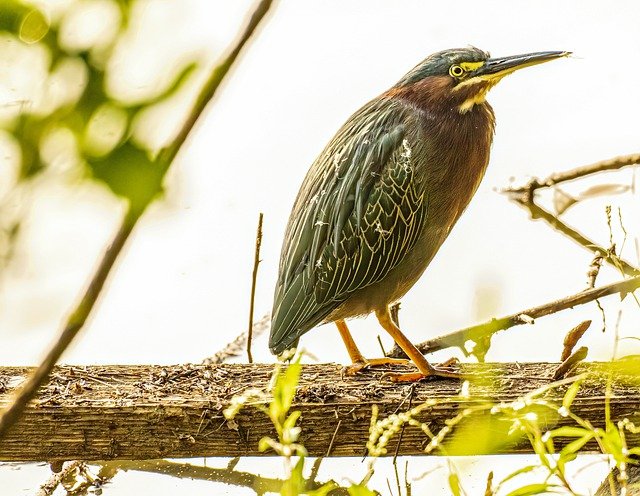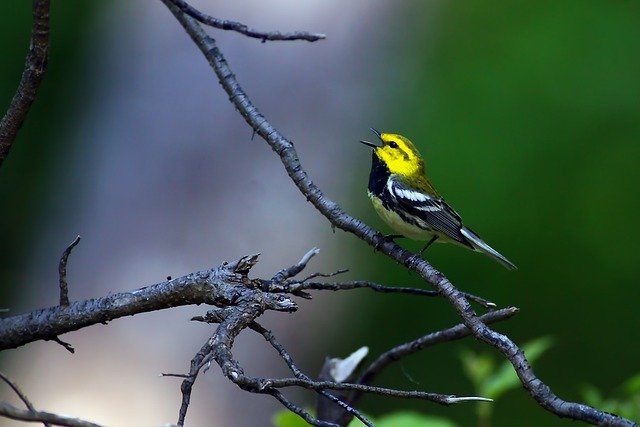Virginia’s skylines showcase many distinct and elegant avian lifeforms, from multicolored specimens, predatory hunters, so on and so forth. If you’ve found yourself on this article, I won’t be going over any of the more exotic or predatory birds, instead I’ll be covering 5 different green birds that consider the state of Virginia home.
- Red Eyed Vireo
- Green Heron
- Ruby Throated Hummingbird
- Black Throated Green Warbler
- Ruby Crowned Kinglet
5 Green Birds In Virginia
1. Red Eyed Vireo (Vireo Olivaceus)

- Size: 11 – 13cm
- Weight: 20 – 24 grams
- Wingspan: 23 – 25cm
Red eyed vireos can be found in Virginia when they’re ready to breed and raise their newborn fledglings. This will typically be around the summer and spring months
These vireos are recognised by there green feathers from the head, wings and back, white feathers on their breast and the stand out red eye. The females look very similar to the males.
As for where you’ll often see these birds perching or flying around, it would include environments with large expanses of deciduous forest, particularly deciduous trees with large leaves, like maple trees for example.
Red eyed vireos tend to eat mostly insects like caterpillars, moths, beetles, wasps, bees, ants, bugs, flies, as well as the occasional fruit and berry.
Red eyed vireos tend to live for around 6 – 7 years, whilst the oldest recorded one died at 10 years and 2 months.
2. Green Heron (Butorides Virescens)

- Size: 40 – 44cm
- Weight: 230 – 250 grams
- Wingspan: 54 – 58cm
These birds can be spotted in Virginia when they’re prepping to breed and raise their newborn kin. This will typically encompass the spring and summer months.
These heron’s are recognised by their darker green back and wings, maroon chest and neck, with yellow legs and a relatively long and pointy black beak. Females on the other hand are mostly brown and gray in color.
Green herons tend to spend the majority of their time around wetlands like lakes, ponds, marshes, swamps, streamsides and rivers.
As for what they consume, it includes a variety of different sources such as small fish like minnows, sunfishes, gizzard shads, crustaceans, aquatic insects, frogs, tadpoles, grasshoppers, snakes, earthworms, snails and other smaller rodents.
Green herons don’t have the longest of lifespans for a bird of their size, with the maximum known life expectancy said to be around 8 years.
3. Ruby Throated Hummingbird (Archilochus Colubris)

- Size: 7 – 9cm
- Weight: 2 – 6 grams
- Wingspan: 8 – 11cm
Ruby throated hummingbirds will migrate to Virginia in preparation for breeding. In this period, which spans over spring and summer, they will mate and the females will raise their offspring untill fit to journey on their own. After this they will start travelling towards an ideal residence to mill over until the end of winter.
A ruby throated hummingbird can be recognised by their plumage that is red, white and green. Their throat is the red part, its breast/stomach white in color and their wings and back an emerald green color. Females are mostly white and green in color.
As for what they eat, it ranges from small insects, fruits, sugar water from feeders, tree sap and of course the nectar produced by blooming flowers.
Ruby throated hummingbirds tend to stay near environments with flowerbeds as these birds have a very strong metabolism that requires them to feed multiple times per hour. Therefore, you can find them in fields, parks, backyards, and open clearings in forests.
As for how long these tiny little hummingbirds can live for, it’s known to be around 3 – 5 years on average with the longest recorded lifespan just short of 7 years.
4. Black Throated Green Warbler (Setophaga Virens)

- Size: 11 – 12cm
- Weight: 7 – 11 grams
- Wingspan: 17 – 20cm
Black throated green warblers are breeding residents in the far east region of Virginia. Throughout the remainder of the state they will typically make their migratory passage.
These birds are recognised by their yellow and green head, and upper back, gray wings, black throat and white belly/breast with a green hue. Females look much the same but, have a duller color palate and the black throat is mostly gray/white for them.
You’ll often find these little birds around a wide variety of forest habitats like conifer forests or mixed hardwood forests as well as cypress swamps on occasion.
They eat mainly insects, smaller fruits, berries or the buds of cecropia trees.
Black throated green warblers are known to live for around 2 – 4 years on average with the longest living one reaching 5 years and 11 months.
5. Ruby Crowned Kinglet (Regulus Calendula)

- Size: 9 – 11cm
- Weight: 5 – 10 grams
- Wingspan: 16 – 18cm
Ruby crowned kinglets will spend their time in Virginia when they aren’t breeding. This will typically encompass the fall and winter months.
These kinglets are recognised by their gray and green plumage throughout, besides the red/orange color on the top of their head. Females look almost the same bar the orange/red element on the head.
Ruby crowned kinglets will often be found by tall, dense conifer forests such as spruce, fir, and tamarack.
These kinglets eat the same food sources as most other birds in the wild, which in this case would be small insects, small berries, seeds and other smaller fruits.
As for how long a ring crowned kinglet can live for, it’s estimated to be around 4 – 6 years.
Amhil Khan, a dedicated nature enthusiast and the founder of BirdsOfTheWild.com, is a passionate advocate for the captivating world of avian wonders. With a deep-seated curiosity about the intricate lives of birds, Amhil’s journey began as a fascination and has evolved into a mission to inspire others to appreciate and protect these magnificent creatures.
Amhil’s love for birds led to the creation of Birds of the Wild, a platform where his expertise in ornithology, coupled with his captivating storytelling, provides readers with an immersive and educational experience. Through his lens and words, he captures the essence of birds in their natural habitats, offering a glimpse into their behaviors, migrations, and the ecosystems they inhabit.

